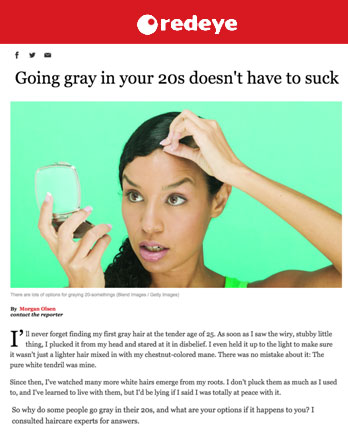Red Eye Chicago
 Going gray in your 20s doesn't have to suck
Going gray in your 20s doesn't have to suck
By Morgan Olsen
I'll never forget finding my first gray hair at the tender age of 25. As soon as I saw the wiry, stubby little thing, I plucked it from my head and stared at it in disbelief. I even held it up to the light to make sure it wasn’t just a lighter hair mixed in with my chestnut-colored mane. There was no mistake about it: The pure white tendril was mine.
Since then, I’ve watched many more white hairs emerge from my roots. I don’t pluck them as much as I used to, and I’ve learned to live with them, but I’d be lying if I said I was totally at peace with it.
So why do some people go gray in their 20s, and what are your options if it happens to you? I consulted haircare experts for answers.
The first thing you should know about grays is that they’re probably not a result of your 70-hour workweek.
"Graying is a function of genetics, not stress,” said dermatologist Dr. Victoria Barbosa, founder of Millennium Park Dermatology and a clinical assistant professor in the Rush University Department of Dermatology. "As we get older, the melanocytes [pigment-producing cells] in our follicles gradually die and are no longer replaced, so there are no cells left to produce melanin, the pigment that gives the hair color.”
Although most people don’t develop gray hairs until their 30s or 40s, it’s not uncommon for 20-somethings to start the process early—especially if it’s in their genes.
"If your mom or dad or someone else in your family started graying in their 20s, then you might be more likely to start graying early also,” Barbosa explained.
But in a world where granny hair is a trend (no, really), premature graying doesn’t have to be the end of the world.
“When it comes to gray hair, the cool thing is everything is kind of OK right now,” said Patrick Lewis, owner and head stylist at Edit Salon in West Town. “You can go gray and it’s completely cool.”
More good news: There are a lot of options when it comes to dealing with those pesky white hairs. Tina Deeke, stylist and color specialist at Maxine Salon in Near North, said most clients who are interested in coloring their hair do one of three things: highlights, lowlights or demi-permanent color.
"If you’re not coloring at all, you can do highlights,” Deeke said. “When you add a lighter tone, the white hair looks like it blends into it. It creates a diffusion of color. If you’re already doing highlights, you could do lowlights to blend the gray down just so it doesn’t look white anymore.”
When highlights and lowlights don’t cut it, all-over color is an option. Demi-permanent color is the sweet spot between semi-permanent and permanent hair color. It’s all-over color that can blend grays, enhance your natural tone and add shine.
Of course, when grays pop up, it can be tempting to run to the drugstore and grab a box dye or a root touch-up kit, but Deeke said those can create bigger problems.
“The box color is more of a permanent color, so you could create another grow-out situation,” she explained. "Sometimes if you put the box color on [grays], it can create a line because your natural color gets altered as well. When it grows out, you see not only the white hairs, but also something going on with your natural color versus the color of the box product.”
Those looking for a super-quick fix are better off buying a colored hair powder that washes out in the shower. "It’s almost like an eyeshadow," Deeke said. "It’s great to just diffuse the white you’re seeing.”
So what about plucking those grays out at first sight? The experts agree that pulling a few here and there won’t do major damage to your locks, but ripping the same hairs again and again can hurt you in the long run.
"Plucking hairs can cause damage to the hair follicles," Barbosa said. "Repeated trauma to the follicles can damage them to the point that no hair will grow from that follicle.”
Oh, and what about that old wives’ tale that plucking one gray causes two more to grow in its place? “This is just a common myth,” Barbosa said.
